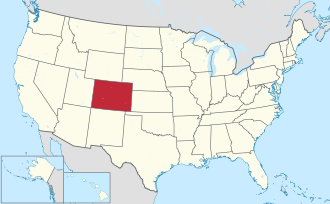History
San Miguel County was given the Spanish language name for "Saint Michael" due to the nearby San Miguel River. On February 27, 1883, Ouray County was split to form San Miguel County. Originally the San Miguel County portion was to retain the name Ouray County with the new portion called Uncompahgre County.
Mining operators in the San Juan mountain area of Colorado formed the San Juan District Mining Association (SJDMA) in 1903, as a direct result of a Western Federation of Miners proposal to the Telluride Mining Association for the eight-hour day, which had been approved in a referendum by 72 percent of Colorado voters. [3] The new association consolidated the power of thirty-six mining properties in San Miguel, Ouray, and San Juan counties. [4] The SJDMA refused to consider any reduction in hours or increase in wages, helping to provoke a bitter strike.
In 1875, the Smuggler gold vein was discovered near Telluride. The Smuggler-Union, Tomboy, and Liberty Bell mines combined produced over a hundred tons of gold by 1920, third in the state of Colorado. [5] : 51, 83
Demographics
Historical population| Census | Pop. | Note | %± |
|---|
| 1890 | 2,909 | | — |
|---|
| 1900 | 5,379 | | 84.9% |
|---|
| 1910 | 4,700 | | −12.6% |
|---|
| 1920 | 5,281 | | 12.4% |
|---|
| 1930 | 2,184 | | −58.6% |
|---|
| 1940 | 3,664 | | 67.8% |
|---|
| 1950 | 2,693 | | −26.5% |
|---|
| 1960 | 2,944 | | 9.3% |
|---|
| 1970 | 1,949 | | −33.8% |
|---|
| 1980 | 3,192 | | 63.8% |
|---|
| 1990 | 3,653 | | 14.4% |
|---|
| 2000 | 6,594 | | 80.5% |
|---|
| 2010 | 7,359 | | 11.6% |
|---|
| 2020 | 8,072 | | 9.7% |
|---|
| 2024 (est.) | 7,819 | [7] | −3.1% |
|---|
|
At the 2000 census there were 6,594 people, 3,015 households, and 1,423 families living in the county. The population density was 5 people per square mile (1.9 people/km2). There were 5,197 housing units at an average density of 4 units per square mile (1.5 units/km2). The racial makeup of the county was 93.57% White, 0.29% Black or African American, 0.85% Native American, 0.74% Asian, 0.08% Pacific Islander, 3.37% from other races, and 1.11% from two or more races. 8.6% of the population were Hispanic or Latino of any race. [13] Of the 3,015 households 22.80% had children under the age of 18 living with them, 38.30% were married couples living together, 5.40% had a female householder with no husband present, and 52.80% were non-families. 32.70% of households were one person and 2.50% were one person aged 65 or older. The average household size was 2.18 and the average family size was 2.77.
The age distribution was 17.60% under the age of 18, 9.90% from 18 to 24, 43.30% from 25 to 44, 25.80% from 45 to 64, and 3.40% 65 or older. The median age was 34 years. For every 100 females there were 120.80 males. For every 100 females age eighteen 18 and over, there were 126.40 males.
The median household income was $48,514 and the median family income was $60,417. Males had a median income of $35,922 versus $30,278 for females. The per capita income for the county was $35,329. About 6.60% of families and 10.40% of the population were below the poverty line, including 11.10% of those under age 18 and 8.00% of those age 65 or over.
In June 2021, U.S. News & World Report ranked the San Miguel County as having the best life expectancy in the United States at 100+ years old. [14] Among all counties in Colorado, San Miguel County has the highest percentage of adults over 25 with at least a bachelor's degree, with 65.2% measured between 2019 and 2023. [15]
This page is based on this
Wikipedia article Text is available under the
CC BY-SA 4.0 license; additional terms may apply.
Images, videos and audio are available under their respective licenses.



